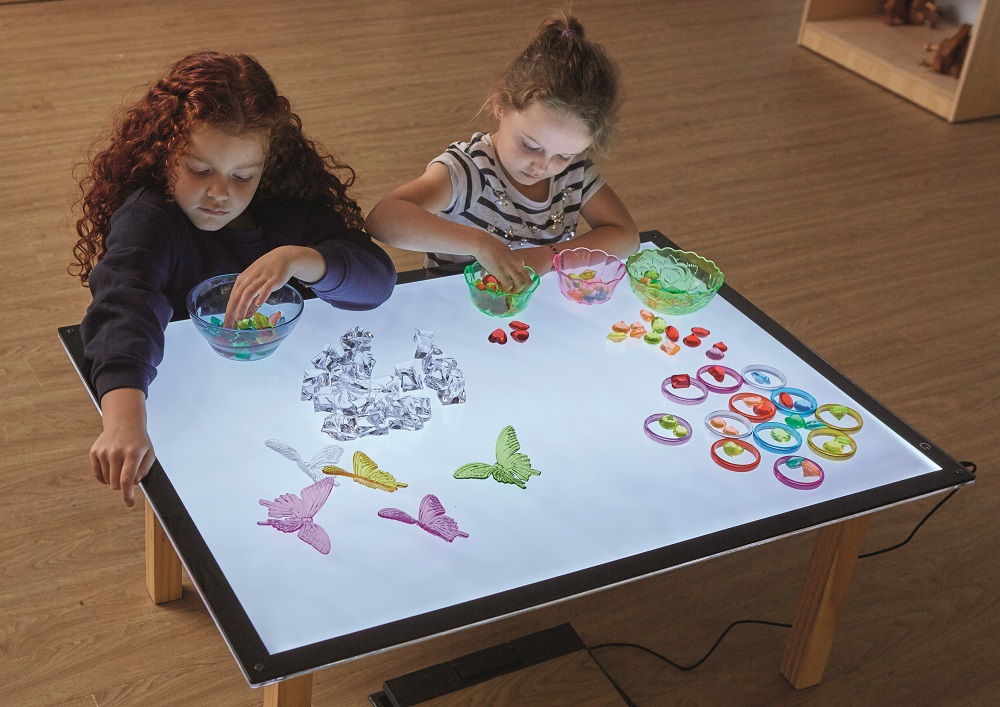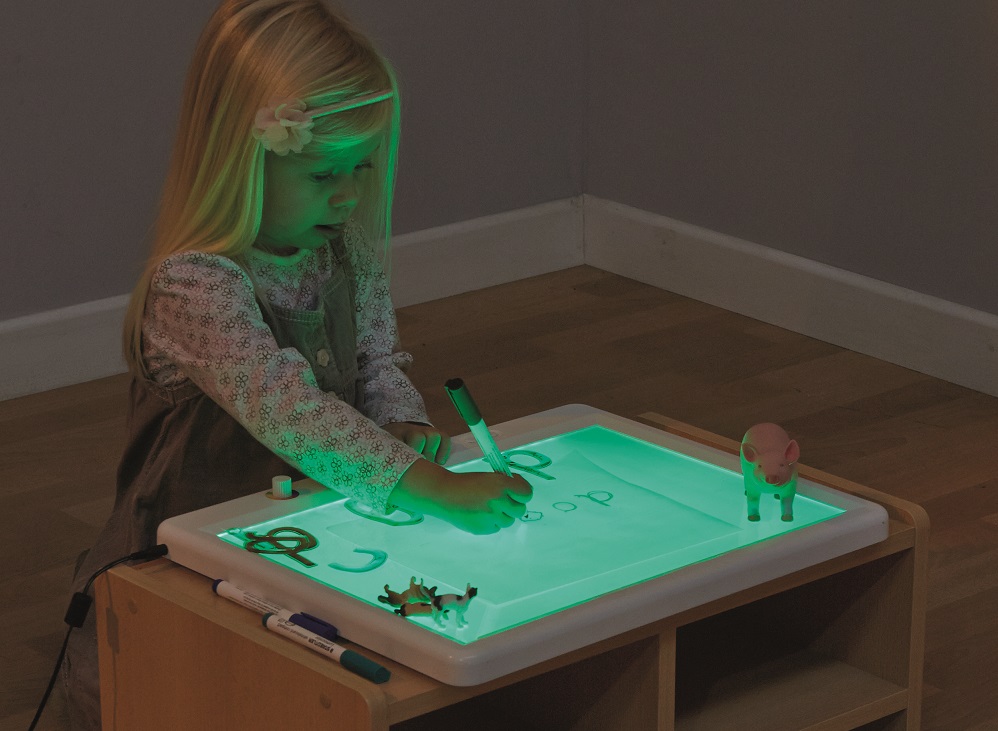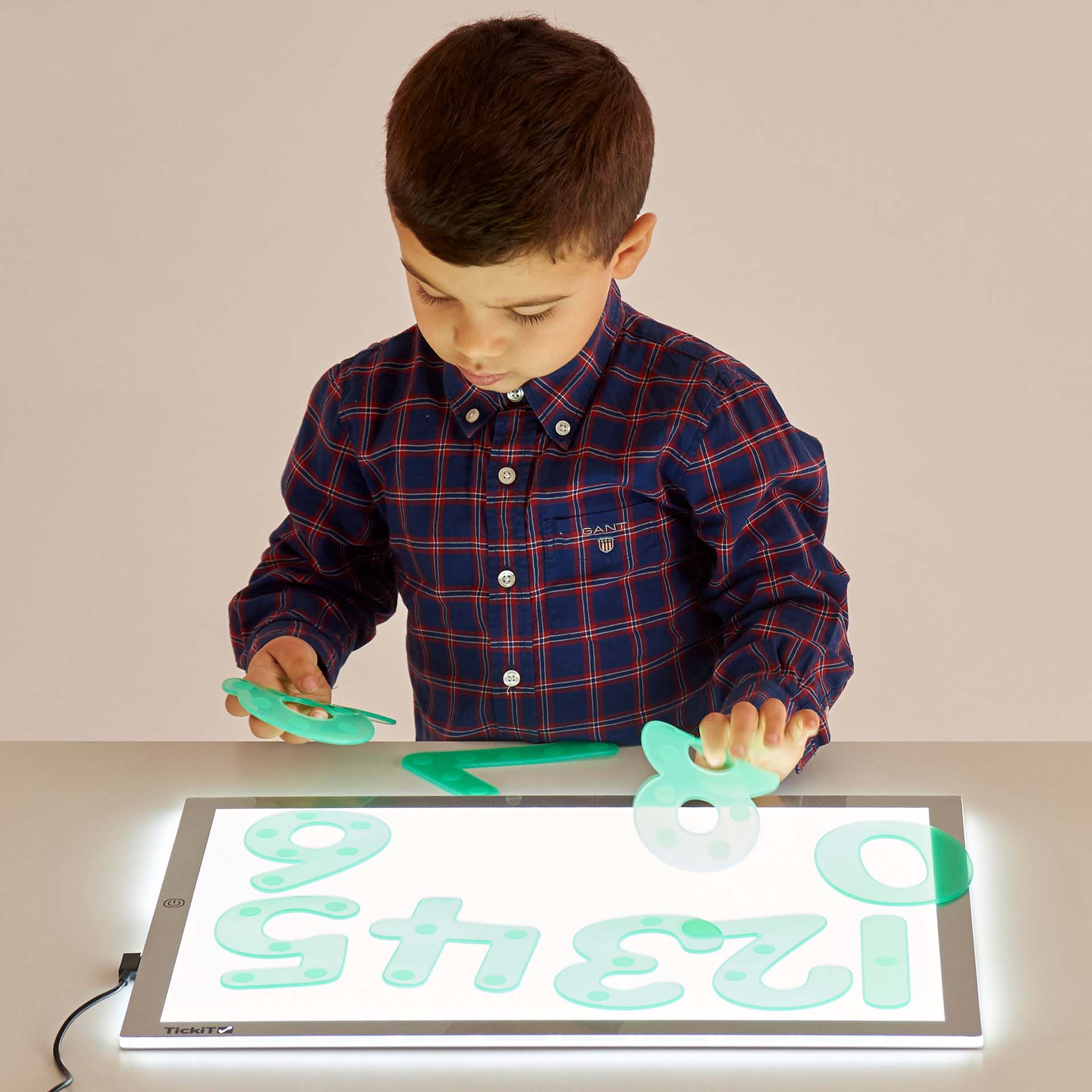BRIGHT IDEAS FOR THE LIGHTED FLOOR
Whoever has no light in his face can never be a star.
W. Blake
I found this aphorism by William Blake a great way to condense what I am about to tell you on the luminous plane, a tool that will “enlighten” your children, helping their minds to shine!
Meanwhile, what is a light plane? The light tables and tops for children are safety glass surfaces, equipped with LED lighting, supplied with a low voltage power supply; light and easy to handle. The tops can be transported and placed anywhere, as long as they are level.
The use of light surfaces as an educational aid is becoming more and more widespread, as a valid teaching tool for the teacher and a fun learning method for children.
A list of over 150 ways to use the luminous planes in teaching has been drawn up, involving the most disparate fields: from the ability to observe, to the union of colors, from creativity to the geometric-mathematical perception of reality, from investigation science to language development. Without neglecting the particular form of relaxation that the light of the luminous planes can instill even in the most lively children.
The luminous floors, at school or at home, attract children as a curious novelty, they facilitate the learning process in different areas, thus “illuminating” them in the broadest sense of the term.
Let’s see together some ways to make the best use of the light planes.
1- Let’s get a series of materials and tools such as color palettes , constructions and transparent colored aids or even just transparent containers, tissue paper or lenses from old glasses, etc. children of colors, light, transparency and opacity.  2- By superimposing materials of different colors, the child will discover how the colors blend, giving life to new shades. Let’s start with the combination of primary colors, to show children how green, orange and purple are the result of a magic of light that combines yellow, blue and red.
2- By superimposing materials of different colors, the child will discover how the colors blend, giving life to new shades. Let’s start with the combination of primary colors, to show children how green, orange and purple are the result of a magic of light that combines yellow, blue and red. 3- We show our children which masterpieces they have been able to create: on the luminous surface any drawing made in watercolor, pencil or tempera, comes to life because the colors, illuminated from below, will be vivid and iridescent and the little artist will be encouraged to give vent to his creativity.
3- We show our children which masterpieces they have been able to create: on the luminous surface any drawing made in watercolor, pencil or tempera, comes to life because the colors, illuminated from below, will be vivid and iridescent and the little artist will be encouraged to give vent to his creativity.
4- In the garden or in the park, we collect many different leaves with the children and, placing them on the light surface, we guide them to discover the various shapes, jagged or linear, and veins. Always leaning on the luminous surface then, the children will be able to make a frottage of the leaf they have observed and thus discover that, what at first glance is not evident, with light and a pastel can be revealed.
Always leaning on the luminous surface then, the children will be able to make a frottage of the leaf they have observed and thus discover that, what at first glance is not evident, with light and a pastel can be revealed.
In this way their natural curiosity is stimulated, inducing them to dwell with more attention on the details of the nature that surrounds them. Any small treasure, in fact, on the luminous plane can reveal interesting secrets: the texture of the shell of a snail, the shape of a shell, the intertwining of a flap of fabric, etc …
5- The light surface is perfect, for older children, in the practice of copying (or “overstretching”): they will have to train their hand and concentration to follow, on their sheet, the contours of the design that is proposed to them.
 6- With the right aids, even learning letters, numbers and geometric shapes becomes more fun on the bright plane! Leaning on it, they will take on game value in the eyes of children, who will no longer see them as boring impositions. With the little finger they will be able to walk along the lines of the various letters and numbers , unwittingly carrying out an important pre-printing activity, preparatory to learning to read and write. And with fun shapes , geometry will capture them and they will gladly learn to recognize shapes and analyze their characteristics.
6- With the right aids, even learning letters, numbers and geometric shapes becomes more fun on the bright plane! Leaning on it, they will take on game value in the eyes of children, who will no longer see them as boring impositions. With the little finger they will be able to walk along the lines of the various letters and numbers , unwittingly carrying out an important pre-printing activity, preparatory to learning to read and write. And with fun shapes , geometry will capture them and they will gladly learn to recognize shapes and analyze their characteristics. 7- The activity of pre-printing or, more simply, of fine motor skills finds an excellent tool in the luminous plane even when used with a transparent tank and sand , so as to create a backlit sand board, also dear to the Montessori method . Thanks to the high edges of the tub, there is no risk of getting dirty around and, in this way, the child has a space all to himself, to practice tracing drawings, lines, writings on the sand … as if he were at the sea , but with the addition of light which, from below, makes the grains of sand even more magical!
7- The activity of pre-printing or, more simply, of fine motor skills finds an excellent tool in the luminous plane even when used with a transparent tank and sand , so as to create a backlit sand board, also dear to the Montessori method . Thanks to the high edges of the tub, there is no risk of getting dirty around and, in this way, the child has a space all to himself, to practice tracing drawings, lines, writings on the sand … as if he were at the sea , but with the addition of light which, from below, makes the grains of sand even more magical! In general, the light surface is a large, rigid and safe support, which follows the child in all his activities, giving him extra stimuli and emotions, thanks to the light that filters through the objects placed on it. Whether you play with dolls, with animals, with figurines or any other toy, in fact, the child will have, with the edge of the light surface, a suggestive frame to set fantastic stories, which he will be stimulated to tell, thus developing his skills. linguistic and lexical.
In general, the light surface is a large, rigid and safe support, which follows the child in all his activities, giving him extra stimuli and emotions, thanks to the light that filters through the objects placed on it. Whether you play with dolls, with animals, with figurines or any other toy, in fact, the child will have, with the edge of the light surface, a suggestive frame to set fantastic stories, which he will be stimulated to tell, thus developing his skills. linguistic and lexical.
But these are just a few ideas for using the light plan: it will be curious to discover, step by step with your children, many other ways to use it as an innovative and fun tool!
Let us know all the activities that will entice you to do!



